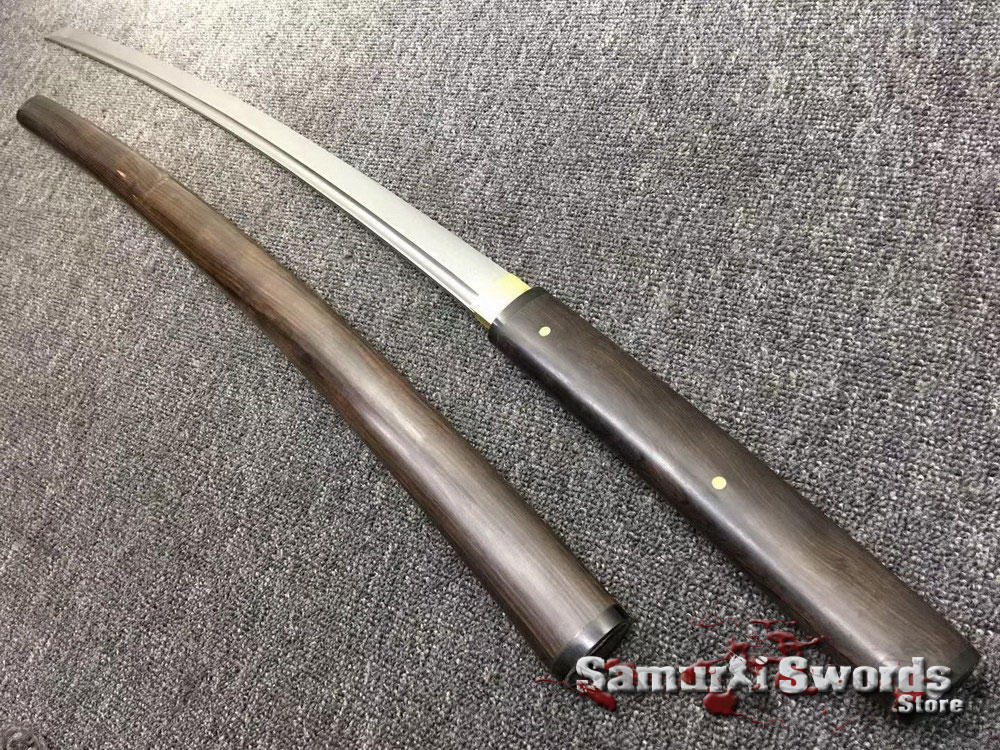Shirasaya Katana 9260 Folded Spring Steel
This Shirasaya Katana is made of 9260 Folded Spring Steel featuering Ebony Wood Saya With Buffalo Horn Fittings
Sword Type: Shirasaya
Steel Type: 9260 Folded Spring Steel
Blade Length: 72 Centimeters
Handle Length: 27 Centimeters
Blade Width: 3.2 Centimeters
Weight: 1.8KG
Tang: Full Tang
Sharpness: Sharpened
Blood Groove: No Bohi (Blood Groove)
Tsuba (Handguard): N/A
Fuchi (Hilt Collar): N/A
Kashira (Pommel): N/A
Menuki (Handle Ornaments): N/A
Saya (Scabbard): Ebony Wood Saya With Buffalo Horn Fittings
Ito (Wrap): N/A
Ray Skin (Samegawa): N/A
Sword Bag: Silk
This fine Shirasaya comes with a blade crafted using 9260 spring steel. It also sports a nice-looking Saya made from ebony wood with a buffalo horn finish.
For its dimensions, this piece weighs a total of 1.8 kilograms and its Tsuka measures 27 centimeters long. The Shirasaya features a 72-centimeter blade that is 3.2 centimeters wide.
Shirasaya Sword’s Tough and Sturdy Blade
The Shirasaya Katana has a 9260 spring steel blade. It has undergone the folding process, thus, making Hada grains appear on the surface. The presence of the Hada adds to the artistic and aesthetic qualities of the blade.
This kind of steel is not only tough but also flexible. It can twist, bend, and shift back to its original form with ease. 9260 steel has a high shock absorption and is excellent for slicing advanced targets. These include bamboo poles and Tatami Mats. (You can read more about our steel types here)
Fully Sharpened and Full Tang Shirasaya
This Shirasaya blade is full tang so it is a single and solid piece to enjoy. It gives the Shirasaya a certain rigidity, and its sharp edge can be further sharpened during the checkout process by choosing the razor sharp option.
Added Allure to the Shirasaya
Adding more to its charm is the Saya. It is made of ebony wood with a nice buffalo finish. This is generally the scabbard of the blade that keeps it from acquiring any scratches or damages.
When it comes to ebony, it is a finely-textured material with a smooth finish once polished. It adds more value to the sword, adding to its aesthetics. There is also an inclusion of a silk sword bag that you can use for carrying this Shirasaya.
The Classic Japanese Shirasaya
One of the most sought after Japanese swords is the Shirasaya. It is also among the favorite pieces that are present. This term literally means white scabbard, yet it does not refer to the color of the Saya.
A classic Shirasaya piece has a Saya made from wood, and smiths often use Hinoki. This is the Japanese Magnolia popular for the lack of excretions. Today, the Shirasaya Saya use materials like bamboo or other visually-aesthetic woods.
The first Shirasaya appeared during the Edo period, around 1603 to 1868 AD. This was the time when laws regarding the carrying of weapons in public appeared.
Following the Edo period was the Meiji era. It was the period when the Japanese society advanced to modernization. Here, only military personnel were those allowed to carry swords which led up and to The Second World War.
When swords had no further use for the Samurai, they had to keep their precious weapons in their homes. This led them to start using the Shirasaya to protect the blades of their Nihonto.
The tight, secure, and snug fit of the Shirasaya provided better protection to the blade. It prevented corrosion and moisture from setting in which can cause damages to the sword.
The Shirasaya was not meant for combat since it did not have a Tsuba. The Tsuba protects the users hand from the opponents weapon. Also, it did not have the proper wrapping on the Tsuka which was necessary when wielding a sword in battle. These wraps are the Tsuka Ito and Samegawa.

